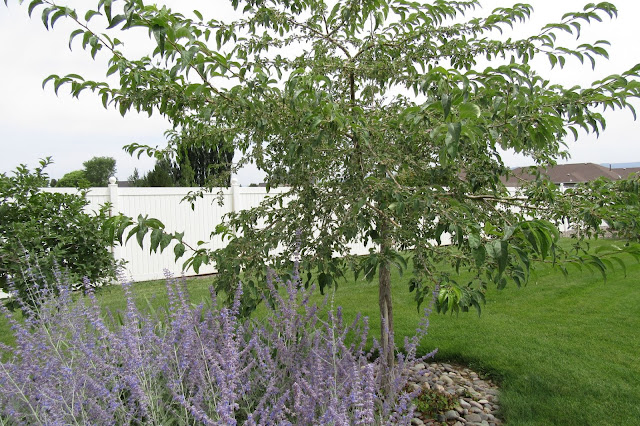 |
| Japanese Crabapple (Malus floribunda): Mother Nature's Montrose Garden |
We
mostly feature native plants from the Western U.S. on this blog. But we’ll occasionally highlight non-native
plants with good garden characteristics.
Some of these are legacy plants in Mother Nature’s Montrose Garden;
plants chosen by the previous gardener.
One such plant, which attracts lots of fruit-eating birds in fall, is
the Japanese Crabapple, Malus floribunda. The scientific name is pronounces
MAL (or MAYL)-us flor-ih-BUN-duh.
Malus is the genus name for the apples,
some of which are native to the U.S. But
the vast majority of species are native to Asia. Japanese Crabapple is native to Japan, which
is one of the reasons it appealed to the previous gardener. It may be a wild species, or may be a hybrid
between two other apple species: Malus sieboldii and M. baccata.
It belongs to the family Rosaceae (the Rose family).
 |
| Japanese Crabapple (Malus floribunda): growth form |
Malus floribunda
is a large shrub
or small tree. It has a somewhat open form, with arching branches. It commonly grows to 15-25 ft. tall (4.5
to7.5 m.) and 20-30 ft. (6-9 m.) wide.
Its smaller size makes it a good choice for smaller yards. It combines many good attributes in a modest-sized
package: summer shade, spring flowers and edible fruits.
 |
| Japanese Crabapple (Malus floribunda): foliage |
The
foliage of Japanese Crabapple is fairly typical for the apple species. The
leaves are medium to dark green, slender ovate, with serrate edges. The species is winter deciduous, losing its
leaves after the first few good frosts. The leaf color is not particularly showy
(golden), but the red-brown young bark and fruits are moderately so, particularly
after leaves are gone.
 |
Japanese Crabapple (Malus floribunda):
attractive in winter
|
 |
| Japanese Crabapple (Malus floribunda): white flowers |
The
flowers are a major reason why this is a popular garden crabapple. The buds are
pink; the flowers begin pale pink and mature to white. The plant is literally covered with flowers. The
species name floribunda means ‘many-flowered’, which well describes this
species.
 |
Japanese Crabapple (Malus floribunda):
typical apple flowers
|
The
flowers themselves are typical for the Rose family: five simple petals and many
prominent stamens (above). The flowers
are sweetly scented and attract a range of pollinators, including bees and
butterflies. The flowers are among the best in the Malus; this and the interesting
growth form earned it the Royal Horticultural Society's Award of Garden Merit.
 |
| Japanese Crabapple (Malus floribunda): maturing fruits |
 |
| Japanese Crabapple (Malus floribunda): edible fruits |
The
fruits of Japanese Crabapple are small, yellow or red crabapples, about 1/3
inch (1 cm) in diameter. The fruits are
showy only after leaves fall. The fruits remain hard until after a good frost,
when they become soft and sweet. The
fruits are small but definitely edible (we often include some in mixed-fruit
jellies). And the fruits are a popular treat
for fruit-eating birds like robins and cedar waxwings. Our little tree has been
stripped by flocks of hungry migrants in a matter of a few days! If you want to provide food for hungry
birds, Japanese Crabapple is a good addition to your garden.
 |
Japanese Crabapple (Malus floribunda):
fruit-eating birds love the fruits
|
Malus floribunda
is relatively easy
to grow. It tolerates some cold, and is recommended for USDA Hardiness Zones 4 –
8. It likes full sun and regular water,
but is not fussy about soil texture. It
tolerates moderately acidic to moderately alkali soils (pH up to at least 8).
Japanese
Crabapple is more resistant than other Malus to the pests and diseases
common to the genus. In fact, it has
been used as breeding stock in the development of disease-resistant cultivars
[1]. That being said, it is an
apple, and subject to some of the usual challenges to apple health. New foliage attracts foliage-eating insects
such as aphids. Scale insects and mites
are also potential problems; these can usually be controlled with horticultural
oil. In areas where they are common,
tent caterpillars can also be a problem.
Japanese
Crabapple is slightly susceptible to apple scab, leaf spot and powdery mildew
and has some susceptibility to fireblight. For more on pests and diseases, and their
control, see ref. 2 (below).
 |
Malus
floribunda is often
used as a small tree in home gardens. In fact, it was first imported to the
U.S. in the 1860’s, and has been used in gardens ever since. It does well as a street tree, as long as
fruits don’t fall on passersby. It makes
a pretty specimen, as both its form and flowers contrast well with surrounding
trees and shrubs.
 |
Japanese Crabapple (Malus floribunda):
provides a contrasting form
|
Japanese
Crabapple can be used as a screen or tall hedge plant. It is amenable to espalier, and can even be
used as a specimen for bonsai. It has a
nice natural form, however, and needs little pruning (unless desired). We’d rate it fairly high as a habitat
plant. It provides pollen and nectar for
the pollinators, and cover, nesting sites and food for the birds. In short, Malus floribunda is worthy
of consideration for Colorado gardens (unless you have a natural aversion to
apple trees!).
___________
_____________________________________________
We
welcome your comments (below). You can
also send your questions to: monaturesmontrosegarden@gmail.com


No comments:
Post a Comment